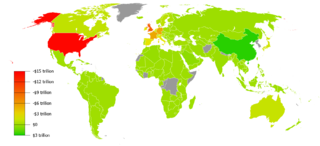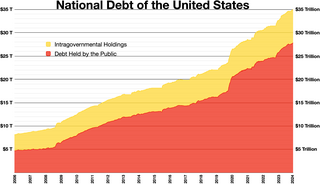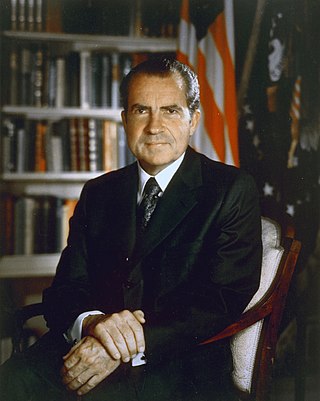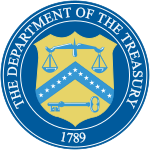Related Research Articles
Special drawing rights are supplementary foreign exchange reserve assets defined and maintained by the International Monetary Fund (IMF). SDRs are units of account for the IMF, and not a currency per se. They represent a claim to currency held by IMF member countries for which they may be exchanged. SDRs were created in 1969 to supplement a shortfall of preferred foreign exchange reserve assets, namely gold and U.S. dollars. The ISO 4217 currency code for special drawing rights is XDR and the numeric code is 960.

A reserve currency is a foreign currency that is held in significant quantities by central banks or other monetary authorities as part of their foreign exchange reserves. The reserve currency can be used in international transactions, international investments and all aspects of the global economy. It is often considered a hard currency or safe-haven currency.

In international economics, the balance of payments of a country is the difference between all money flowing into the country in a particular period of time and the outflow of money to the rest of the world. In other words, it is economic transactions between countries during a period of time. These financial transactions are made by individuals, firms and government bodies to compare receipts and payments arising out of trade of goods and services.

The national debt of the United States is the total national debt owed by the federal government of the United States to Treasury security holders. The national debt at any point in time is the face value of the then-outstanding Treasury securities that have been issued by the Treasury and other federal agencies. The terms "national deficit" and "national surplus" usually refer to the federal government budget balance from year to year, not the cumulative amount of debt. In a deficit year the national debt increases as the government needs to borrow funds to finance the deficit, while in a surplus year the debt decreases as more money is received than spent, enabling the government to reduce the debt by buying back some Treasury securities. In general, government debt increases as a result of government spending and decreases from tax or other receipts, both of which fluctuate during the course of a fiscal year. There are two components of gross national debt:

The Bretton Woods system of monetary management established the rules for commercial relations among the United States, Canada, Western European countries, and Australia among 44 other countries after the 1944 Bretton Woods Agreement. The Bretton Woods system was the first example of a fully negotiated monetary order intended to govern monetary relations among independent states. The Bretton Woods system required countries to guarantee convertibility of their currencies into U.S. dollars to within 1% of fixed parity rates, with the dollar convertible to gold bullion for foreign governments and central banks at US$35 per troy ounce of fine gold. It also envisioned greater cooperation among countries in order to prevent future competitive devaluations, and thus established the International Monetary Fund (IMF) to monitor exchange rates and lend reserve currencies to nations with balance of payments deficits.
The Mexican peso crisis was a currency crisis sparked by the Mexican government's sudden devaluation of the peso against the U.S. dollar in December 1994, which became one of the first international financial crises ignited by capital flight.
Foreign exchange reserves are cash and other reserve assets such as gold held by a central bank or other monetary authority that are primarily available to balance payments of the country, influence the foreign exchange rate of its currency, and to maintain confidence in financial markets. Reserves are held in one or more reserve currencies, nowadays mostly the United States dollar and to a lesser extent the euro.
The history of the United States dollar began with moves by the Founding Fathers of the United States of America to establish a national currency based on the Spanish silver dollar, which had been in use in the North American colonies of the Kingdom of Great Britain for over 100 years prior to the United States Declaration of Independence. The new Congress's Coinage Act of 1792 established the United States dollar as the country's standard unit of money, creating the United States Mint tasked with producing and circulating coinage. Initially defined under a bimetallic standard in terms of a fixed quantity of silver or gold, it formally adopted the gold standard in 1900, and finally eliminated all links to gold in 1971.

The Nixon shock was a series of economic measures undertaken by United States President Richard Nixon in 1971, in response to increasing inflation, the most significant of which were wage and price freezes, surcharges on imports, and the unilateral cancellation of the direct international convertibility of the United States dollar to gold.
The Emergency Economic Stabilization Act of 2008, also known as the "bank bailout of 2008" or the "Wall Street bailout", was a United States federal law enacted during the Great Recession, which created federal programs to "bail out" failing financial institutions and banks. The bill was proposed by Treasury Secretary Henry Paulson, passed by the 110th United States Congress, and was signed into law by President George W. Bush. It became law as part of Public Law 110-343 on October 3, 2008. It created the $700 billion Troubled Asset Relief Program (TARP), which utilized congressionally appropriated taxpayer funds to purchase toxic assets from failing banks. The funds were mostly redirected to inject capital into banks and other financial institutions while the Treasury continued to examine the usefulness of targeted asset purchases.
The Term Asset-Backed Securities Loan Facility (TALF) is a program created by the U.S. Federal Reserve to spur consumer credit lending. The program was announced on November 25, 2008, and was to support the issuance of asset-backed securities (ABS) collateralized by student loans, auto loans, credit card loans, and loans guaranteed by the Small Business Administration (SBA). Under TALF, the Federal Reserve Bank of New York authorized up to $200 billion of loans on a non-recourse basis to holders of certain AAA-rated ABS backed by newly and recently originated consumer and small business loans. As TALF money did not originate from the U.S. Treasury, the program did not require congressional approval to disburse funds, but an act of Congress forced the Fed to reveal how it lent the money. The TALF began operation in March 2009 and was closed on June 30, 2010. TALF 2 was initiated in 2020 during the COVID-19 pandemic.
The subprime mortgage crisis reached a critical stage during the first week of September 2008, characterized by severely contracted liquidity in the global credit markets and insolvency threats to investment banks and other institutions.

The Australian government debt is the amount owed by the Australian federal government. The Australian Office of Financial Management, which is part of the Treasury Portfolio, is the agency which manages the government debt and does all the borrowing on behalf of the Australian government. Australian government borrowings are subject to limits and regulation by the Loan Council, unless the borrowing is for defence purposes or is a 'temporary' borrowing. Government debt and borrowings have national macroeconomic implications, and are also used as one of the tools available to the national government in the macroeconomic management of the national economy, enabling the government to create or dampen liquidity in financial markets, with flow on effects on the wider economy.
Monetary policy in the United States is associated with interest rates and availability of credit.

The Mexican Debt Disclosure Act is a law of the United States formulating congressional oversight and monetary policy, through reports of the US president and the US treasury, to support the strength of the 1995 peso currency of Mexico; all resulting from speculative capital flight and the Mexican peso crisis of 1994. The Act required the submission of monthly reports by the United States Secretary of the Treasury concerning all international guarantees, long-term, and short-term currency swaps with the federal government of Mexico. The U.S. Congressional bill required the submission of semi-annual reports by the President of the United States concerning presidential certifications of all international credits, currency swaps, guarantees, and loans through the exchange stabilization fund to the government of Mexico.
India has large foreign-exchange reserves; holdings of cash, bank deposits, bonds, and other financial assets denominated in currencies other than India's national currency, the Indian rupee. The reserves are managed by the Reserve Bank of India for the Indian government and the main component is foreign currency assets.
In 1945, China cofounded the International Monetary Fund (IMF) with 34 other nations. China was initially represented by the Republic of China. In April 1980, representation transferred to the People's Republic of China. The Chinese-IMF relationship mainly operates around affairs associated with IMF governance and the IMF Special Drawing Rights (SDR).
South Korea and the International Monetary Fund (IMF) partner together to assist the country in managing its financial system. South Korea's economy is considered fundamentally sound because of the balance of their banking sector and their aim toward a zero structural balance without compromising their ability to sustain debt. The IMF Board in 2019 assessed that the policy framework and financial system in place are sturdy and firmly set.
The United States was a founding member of the International Monetary Fund (IMF), having hosted the other countries at the IMF’s founding conference, the Bretton Woods Conference, in 1944. The US delegation played an integral role in the establishment of the basic tenets of the IMF and maintains a large presence in the workings of the organization.
References
- ↑ Gertrude Chavez-Dreyfuss (2019-08-07). "U.S. dollar - When will bulls turn to bears?". Reuters. Retrieved 2019-08-07.
- ↑ Treasury Bulletin (Report). March 2020.
- ↑ 31 U.S.C. § 5302
- ↑ Anna J. Schwartz. "IMF's Origins as a Blueprint for Its Future".
- ↑ 22 U.S.C. § 286o
- ↑ "Exchange Stabilization Fund: Legislative Basis". Archived from the original on 2008-09-17.
- ↑ "Exchange Stabilization Fund: Finances & Operation". Archived from the original on 2008-09-17.
- 1 2 3 Schwartz, Anna J. (May 1997). "From Obscurity to Notoriety: A Biography of the Exchange Stabilization Fund". Journal of Money, Credit and Banking. 29 (2): 135–153.
- ↑ Garbade, Kenneth R. (June 2016). The First Debt Ceiling Crisis (Report). Federal Reserve Bank of New York Staff Reports. No. 783.
- ↑ Pub. L. 104–6, title IV, Apr. 10, 1995, 109 Stat. 89, 31 U.S.C. § 5302
- ↑ Greenspan, Alan (2007). The Age of Turbulence . Penguin Press. ISBN 978-1-59420-131-8.
- ↑ Treasury’s Exchange Stabilization Fund and COVID-19 (Report). In Focus. Congressional Research Service. April 10, 2020. IF11474.
- ↑ "Coronavirus Aid, Relief, and Economic Security Act".
- ↑ Crutsinger, Martin (December 1, 2020). "Mnuchin defends shut down of Fed emergency loan programs". AP. Retrieved 2023-03-01.
- ↑ Audit of the Exchange Stabilization Fund’s Financial Statements for Fiscal Years 2021 and 2020 (PDF) (Report). Audit Report. Office of Inspector General, Department of the Treasury. March 9, 2022. OIG-22-029. Retrieved 2023-02-07.
- ↑ Treasury Bulletin (Report). March 2023.
- ↑ ESF Annual Report for Fiscal Year 2022
- ↑ Cox, Jeff (March 12, 2023). "U.S. government steps in and says people with funds deposited at SVB will be able to access their money". CNBC. Retrieved 2023-03-13.
